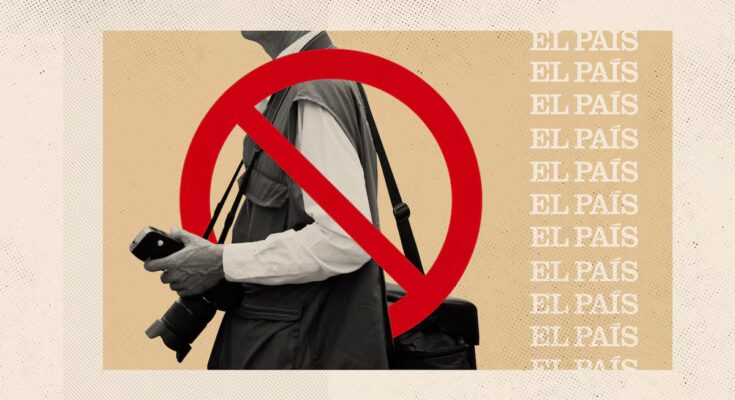More and more photos are published on EL PAÍS that were not taken by photographers working according to the principles of journalism. At the beginning they were images impossible to obtain in any other way, as in those events in which only those captured by witnesses with their cell phones exist. However, little by little, the newspaper has accepted that companies, brands, political parties, artists and institutions creep into its snapshots, in which the control of its image prevails over information. The expressions written in the captions for these cases, such as pool, photos provided, please, “in an image of…”, are euphemisms that hide the fact that no photographer from the newspaper (or a news agency) went to the location or, even worse, that they were not allowed to do their job.
Photography editor-in-chief Moeh Atitar says the latter is an increasingly common situation: “It’s not that we don’t want to or can’t go, which happens; it’s that we don’t have the ability to be there.” A recent example was Radiohead concert on November 4 in Madrid, a rare occasion in which the incident was detailed in the news caption: “Thom Yorke (…), in an image provided by the group, as he did not let media photographers in.”
Since nothing is usually indicated, this little glossary will help the reader discern what kind of photo he has in front of him:
Image released by. The photo makes news in which it was reported on Monday that the American investment fund Apollo purchased the majority of Atlético Madrid shares portrays Miguel Ángel Marín, Enrique Cerezo and Robert Giovone, partner of the fund. The caption reads: “In an image released by Atlético after the deal.” This is not a journalistic photograph, but a promotional one, taken by the football club without further witnesses. In similar cases the formulas “photo provided”, “image of” or “spread by” are also used, and it is rare for the author to appear.
Pool. The state attorney general’s trial in the Supreme Court was another example of a space inaccessible to photojournalism, as a swarm of photographers worked outside the building every day. Except for the first day, November 3, when the court admitted a photojournalist from the Efe agency, the Criminal Court was closed. The court’s press officer explains that they have accredited 27 newspapers and seven agencies and that, for reasons of space, not all their photographers will be able to enter. In all trials in Spain, he underlines, the cameras only have access on the first day, because they must be “public, but not advertised”.
For this reason, the only images of the first state attorney general on the bench of the Supreme Court are the screenshots of the institutional video signal, which the court’s editorial team used to follow the sessions. Their quality was very low, which especially suffered in the printed edition. There will therefore be no photographs in the newspaper archive that can be used as historical documents in the future.
In the newspaper there was only one photo of Álvaro García Ortiz on the first day of the trial, published on the 4th. The signature corresponds to JJ Guillén, of the Efe agency, and then, in brackets, the word was added pool. Not only is it a cryptic term for readers, who have conveyed their confusion to me, but it absolutely should not be applied to this situation.
In the definition of the Columbia Journalism School manual, Reporting and News Writing (1977)by Professor Melvin Mancher, a pool This is an agreement between photographers or reporters who cover a news story, who choose among themselves a limited number of professionals who will participate in the event and then share the resulting material.
In the attorney general’s trial there was no agreement among the media, but it was the Supreme Court that appointed the Efe, as has been done for decades, according to its press chief. It is the same thing that other institutions such as the King’s House or the Government do. For example, when Pedro Sánchez met Volodímir Zelenski at the Davos (Switzerland) forum in January, a photographer from La Moncloa took the photo which was later distributed with the credit of pool.
What should be an agreement between professionals becomes an imposition in these cases. This limits the right to information, as it only allows a journalistic point of view. Therefore, it should not even be called pool.
Courtesy. Giving a photo the title “courtesy of” is another euphemism for promotional images. In the review of a low consumption mini heater published on Wednesday on Dispay window, indicates the caption “courtesy of Amazon.” The expression is unfortunate because it suggests that the brand had a detail, when the image has a clear advertising function.
Conclusion. The photos play an informative role and, almost always, become documentary evidence that attests to the facts, as happened with the thousands of images of how Israel devastated Gaza. When the Style book stresses that EL PAÍS must strive to “present truthful information on a daily basis, as complete as possible, interesting, current and of high quality” including photography. But admitting original photos so often lowers the bar.
It would be unacceptable for the newspaper to give up defending the right to information. This is why it is essential to publicly denounce every time photojournalism is hindered, as happened with Radiohead. To do this requires a thorough overhaul of how images are credited: clarifying their origin, unifying criteria, and eliminating confusing euphemisms. By highlighting the work of photojournalists, we will help readers differentiate journalistic work from propaganda.
To contact the defender you can write an email to defender@elpais.es or send an audio lasting up to one minute via WhatsApp to the number +34 649 362 138 (this phone does not answer calls).



